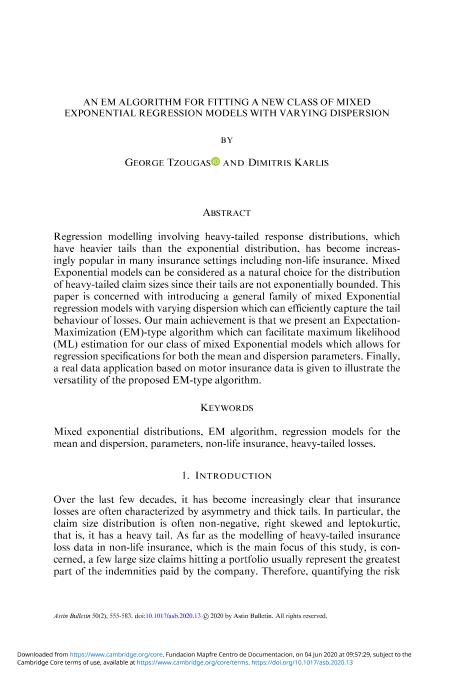An EM algorithm for fitting a new class of mixed exponential regression models with varying dispersion

Contenido multimedia no disponible por derechos de autor o por acceso restringido. Contacte con la institución para más información.
| Tag | 1 | 2 | Valor |
|---|---|---|---|
| LDR | 00000cab a2200000 4500 | ||
| 001 | MAP20200019121 | ||
| 003 | MAP | ||
| 005 | 20200610090110.0 | ||
| 008 | 200604e20200501bel|||p |0|||b|eng d | ||
| 040 | $aMAP$bspa$dMAP | ||
| 084 | $a6 | ||
| 100 | 1 | $0MAPA20140009800$aTzougas, George | |
| 245 | 1 | 0 | $aAn EM algorithm for fitting a new class of mixed exponential regression models with varying dispersion$cGeorge Tzougas, Dimitris Karlis |
| 520 | $aRegression modelling involving heavy-tailed response distributions, which have heavier tails than the exponential distribution, has become increasingly popular in many insurance settings including non-life insurance. Mixed Exponential models can be considered as a natural choice for the distribution of heavy-tailed claim sizes since their tails are not exponentially bounded. This paper is concerned with introducing a general family of mixed Exponential regression models with varying dispersion which can efficiently capture the tail behaviour of losses. Our main achievement is that we present an Expectation- Maximization (EM)-type algorithm which can facilitate maximum likelihood (ML) estimation for our class of mixed Exponential models which allows for regression specifications for both the mean and dispersion parameters. Finally, a real data application based on motor insurance data is given to illustrate the versatility of the proposed EM-type algorithm. | ||
| 650 | 4 | $0MAPA20080579258$aCálculo actuarial | |
| 650 | 4 | $0MAPA20080553128$aAlgoritmos | |
| 650 | 4 | $0MAPA20080592011$aModelos actuariales | |
| 650 | 4 | $0MAPA20080602611$aModelos de dispersión | |
| 700 | 1 | $0MAPA20200013471$aKarlis, Dimitris | |
| 773 | 0 | $wMAP20077000420$tAstin bulletin$dBelgium : ASTIN and AFIR Sections of the International Actuarial Association$x0515-0361$g01/05/2020 Volumen 50 Número 2 - mayo 2020 , p. 555-583 |

